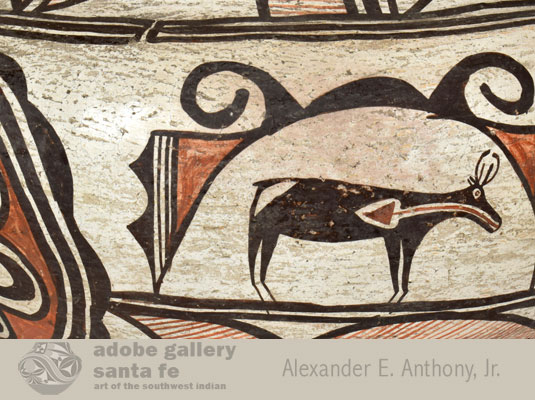Historic Zuni Pueblo Polychrome Olla with Heartline Deer and Rosette [SOLD]
+ Add to my watchlist Forward to Friend
- Category: Historic
- Origin: Zuni Pueblo, SHE-WE-NA
- Medium: clay, pigment
- Size: 8-½” height x 12-¼” diameter
- Item # C4135A SOLD
Pottery has been made at New Mexico pueblos for at least 2,000 years. Styles changed over those years and names have been applied to designs and styles as changes occurred. At Zuni, predecessor pottery types have been designated as the following:
Matsaki Polychrome (circa 1475-1680)
Hawikuh Polychrome (circa 1630-1680)
Ashiwi Polychrome (circa 1700-1760)
Kiapkwa Polychrome (circa 1760-1840/1860)
Zuni Polychrome (circa 1860-present day)
There are several individual design elements on Zuni Polychrome jars that are interesting historically as to their origins. There are rosettes, daggers, birds, heartline deer and the deer houses.
The rosette or medallion resembles a flower, perhaps a sunflower. It is a symbol also seen on the mask of the Salimopiya Katsina. It primarily appears on ollas but sometimes seen on the interior of bowls. The design varies according to a potter’s preference. There can be single levels or multiple levels of petals. This jar is a single petal style, the simplest encountered. Where did this design originate? It first appears on Zuni pottery around 1870 and possibly was influenced by carved sunflowers on wooden chests brought to New Mexico or made locally by New Mexican furniture makers. Lanmon & Harlow 2008:153
The dagger design seen on necks of jars is represented by the black outlined neck design filled with red fine lines. There are detached handles and complete daggers on the neck of this jar and they are adjacent. The full dagger has a long bird’s-like beak and eye. According to Zuni informants, the dagger represents “the thunder knife which priests use in many ceremonies.” Lanmon & Harlow 2008:171
Heart-line deer are certainly one of the most recognizable design elements on a Zuni jar. It has been speculated that they actually represent elk or sometimes antelope, but they will be called heart-line deer forever. “The animals have a line (usually red) extending from mouth to the position of the heart, this organ being represented by an arrowhead or a swollen blob. . . This line may also represent the sacred breath of life of the animal: in a Zuni legend, a young hunter is told to shoot an arrow at a stag and ‘should he fall, quickly go to him, throw your arms around him, put your lips close to his, breathe in his breath and say ‘Thanks my father, this day I have drunken your sacred wind of life.” Lanmon & Harlow 2008: 257 The animal usually has a white rump as illustrated in this jar.
The heart-line deer are generally housed in a cave-like house, apparently to isolate and highlight the importance of the animal to the overall design. Often, the deer are shown with hooves but in this jar the hooves are incorporated into the brown line on which the animal stands.
On this jar, the potter chose to eliminate a row of birds. She instead drew a modified rain bird design below the deer and filled it with red lines. The base of the jar is the traditional dark brown and concave. The rim is dark brown with the pigment extending just slightly to the inside of the jar. The jar appears to be dated to about 1890-1900.
Condition: this Historic Zuni Pueblo Polychrome Olla with Heartline Deer and Rosette is in very good condition
Provenance: This jar was part of a collection of the Jacob Barth family. Mr. Barth’s father, Solomon Barth, had a trading post and general merchandise store called Barth Mercantile in St. Johns, Arizona, around the turn of the last century (1800s). Some of the Barth collection was given to the Museum of Northern Arizona in Flagstaff. Other items were retained by the family.
Reference: The Pottery of Zuni Pueblo by Lanmon and Harlow

- Category: Historic
- Origin: Zuni Pueblo, SHE-WE-NA
- Medium: clay, pigment
- Size: 8-½” height x 12-¼” diameter
- Item # C4135A SOLD



